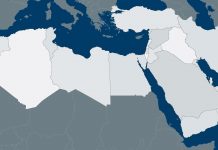By George Friedman
Japanese Defense Minister Gen Nakatani announced on Feb. 3 that he has ordered the deployment of Aegis destroyers in the Sea of Japan and Patriot missile batteries onshore, promising to shoot down any missile that threatens the country. The announcement came hours after North Korea stated it was preparing to launch a satellite, which some suspect is being used as a missile test. Earlier in the week, Japan declared it would spend 13 billion yen ($110 million) to build a monitoring station on the small island of Okinotorishima, about 1,000 miles south of Tokyo. The announcements are directed against different threats, but combined they give us a sense of Japanese national strategy.
Japan faces two potential regional threats. The first is North Korea, whose nuclear weapon program could theoretically pose a direct threat to Japan. I say theoretically because the state of North Korea’s nuclear and missile programs remains somewhat murky, and the process of preparing a nuclear-armed missile for launch would be visible to major intelligence services – or so the North Koreans would have to assume. If they did have such programs, they might be vulnerable to pre-emptive attacks. In addition, it is not clear that Japan would be the primary target of a North Korean attack. These factors would seem to make North Korea less of a problem for Japan, but Japan must assume the worst-case scenario. Its only counters are anti-missile systems, and the United States. But depending on a third party to protect a country in war or retaliate on its behalf is always dicey.
The other regional threat is China. Most observers focus on the Chinese interest in various islands in the East and South China seas. From a strategic sense these islands are less significant than the noise that is made about them. China’s real concern is being trapped in the choke points created by the geography of the islands surrounding these seas. But there is no navy that can use those choke points to contain China except the U.S. Navy. Japan is incapable of doing it, and if the United States should decide to block China, China has no effective counter but to launch missile attacks on U.S. ships. China would then face counterattacks by the U.S. The Japanese are not primarily concerned with such a confrontation. It is unlikely and is not a conflict the Japanese can participate in.
Obviously, Japan wants to be as prepared as possible for regional events, but it has a broader problem. Japan is a global power with regional reach. Japan is unique among advanced industrial countries not because it requires the import of some raw materials, but because it must import all of them. This gives Japan a unique position in the arithmetic of raw material. If it reduces the consumption of iron by 50 percent, it must still import 100 percent of the iron ore it continues to use. If it gets only 10 percent of its energy supply from coal, it still must import 100 percent of this supply. If the price of oil falls to $20 a barrel, it still cannot produce oil on its own and must import 100 percent of it.
Regardless of the quantity it needs, or the price, Japan’s dependence on foreign sources of raw materials remains at 100 percent. The primary sources of those raw materials are Australia, Indonesia, the Persian Gulf and other locations that have two common characteristics from Japan’s point of view: they are all far away and can only ship to Japan by sea. China is also dependent on the import of raw materials, but not as absolutely as Japan is. China has supplies of most raw materials and as consumption drops, the percent that it must import declines. Its dependence is relative to requirements. Japan’s dependence, however, is independent of requirements and of price and is always 100 percent.
This has been true since Japan industrialized. The country’s dependence on imports was the prime cause of WWII’s extension into the Pacific and shaped this part of the conflict. Japan depended on the supply of raw materials from French Indochina and the Netherlands East Indies (NEI). France and the Netherlands supplied Japan with rubber, tin, oil and other materials, as part of treaty agreements. When Germany overran France and the Netherlands, these colonies became the battleground between various factions in exile.
In addition, the United States put pressure on the colonial governments to stop shipments of raw materials to Japan. The United States went so far as to buy up NEI’s oil so the Japanese couldn’t obtain it. The Japanese moved into Indochina to guarantee their supplies and the U.S. cut off the sale of oil and scrap iron from the United States. The Japanese had perhaps a six-month supply of oil, after which it would cease being an industrial power. The U.S. hoped to force Japan to make concessions. Japan, knowing that if it capitulated it would become an American vassal, chose war. The U.S. could interdict Japanese supplies shipped from the south if it held the Philippines. Therefore, Japan had to take the Philippines to secure NEI and Indochina but it knew the U.S. fleet would sail west and perhaps defeat Japan’s navy. So it struck the U.S. fleet at Pearl Harbor, triggering the Americans’ entry into the war.
Geopolitical reality changes slowly. Japan still imports from the south – some supplies passing through the Strait of Malacca, others moving through the South China Sea and all throughout the East China Sea. Japan has relied on this supply of resources to become a global power. But even more than before World War II, it lacks the ability to guarantee its access to the sea lanes necessary to secure this supply. Since the end of World War II, the Japanese have depended on the United States to guarantee Japan’s access to these resources. During the Cold War, the Japanese were important to the U.S. strategically, blocking the Soviet fleet from the Pacific. After the Cold War ended, the U.S.-Japanese relationship became one based on routine – a routine based on good will, but a routine nonetheless.
The rise of the Chinese and North Korean threats created more commonality. The United States had an interest in containing China and concern about North Korea. The U.S. is not always as reliable a partner as other nations would want. It can afford to be obsessed with the Middle East, but its Asian partners become nervous. Japan, the third largest economy in the world, must always be concerned when the U.S. is casual about any force that would interdict the flow of oil supplies from the south. China’s interest in breaking through its maritime encirclement also flows from Chinese fear of U.S. interference in its sea lanes. So the Chinese are concerned about excessive U.S. interest, while the Japanese are frightened of decreased U.S. interest in the region.
Japanese strategy is, therefore, to protect itself from North Korea as best it can and to provide a degree of security against Chinese interdiction of its sea lanes, but it can currently only do that effectively within a roughly 1,000-mile radius. Its blue water capability cannot match a determined China. Japan utterly depends on the U.S. and the U.S. has an interest in ensuring Japan’s sea lanes.
But there is a vast difference between utter dependence and an interest. That asymmetry frightens Japan, as does excessive exposure. Japan has the industrial capability to match China with superior technology – much of it, like Aegis, secured from the United States. At the same time, it is not so much the cost as the shifted posture that might attract hostile attention that concerns Japan.
This is how to understand the two moves – Japan’s threat to shoot down North Korean missiles and its construction of a monitoring station on Okinotorishima – with which I began. Japan will take the minimal steps it can within the framework of American strategy, always watchful of American attention drifting away. It has access to American weapons and can field a sophisticated capability within limits. Tokyo will push forward with small steps, not testing its limits, but looking to the U.S. and measuring its satisfaction with Japanese burden sharing.
But in the end, the sea lanes pose an existential challenge to Japan and dependence on a third power for existential matters is always risky. So Japan steps ahead and waits, never quite committed to total dependence on the U.S., never quite committed to depending on itself. Japan is a nation caught between self-reliance and dependency. Sending American-made boats and missiles to guard against North Korea and building a place to watch for trouble, without deploying a force to defeat the threat, demonstrates this ambiguity.







 The Geopolitics of the American President
The Geopolitics of the American President